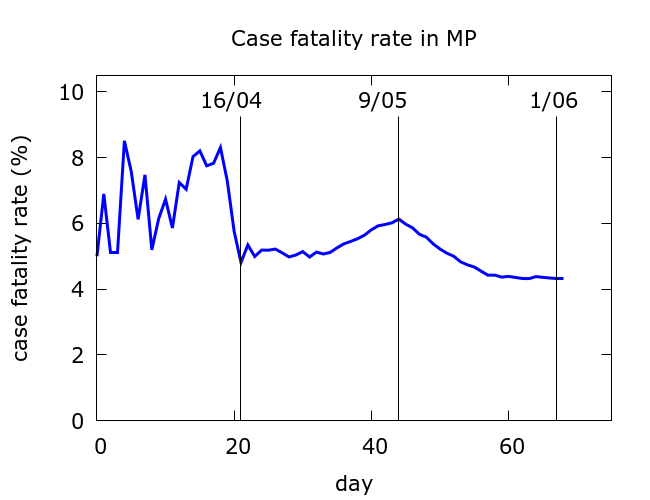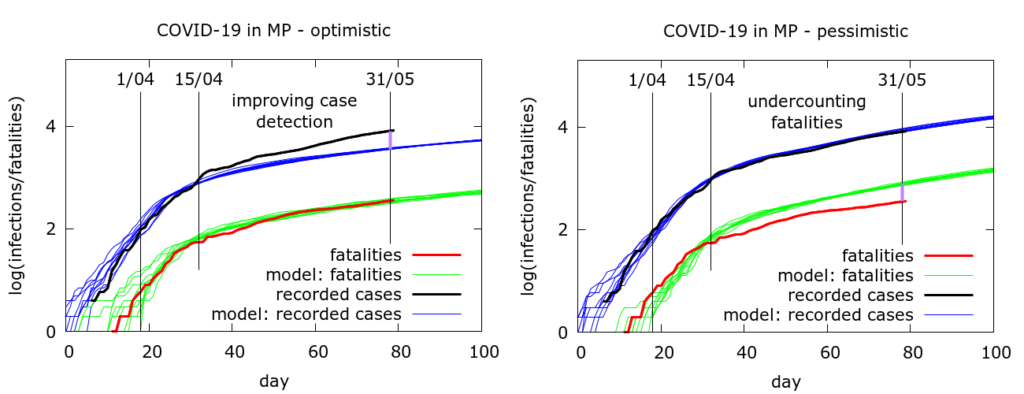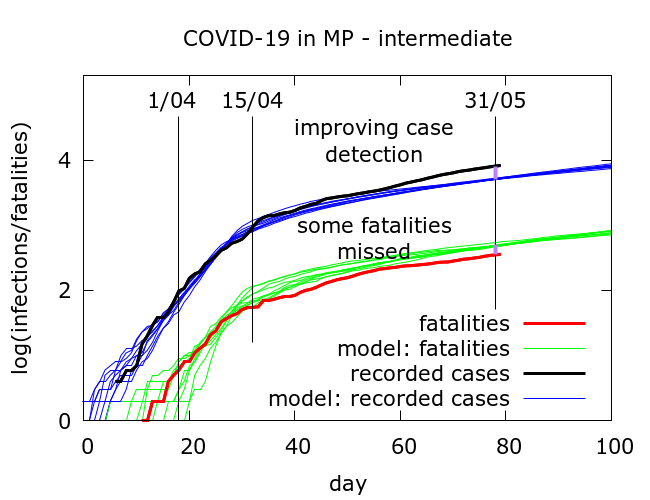(Murad Banaji, 02/06/2020)
Let’s see what modelling and the data tell us about COVID-19 in Madhya Pradesh. The main question: are there COVID-19 deaths going unrecorded in MP? The idea is to look carefully at both testing and fatality data – similar to what I did for Delhi and Tamil Nadu – and see if we can draw any firm conclusions.
The question about missing deaths is a natural one to ask, both because in other states there have been documented cases of significant numbers of deaths not being reported, and also in the light of media reports about MP itself. In late April it was being reported that there were surges in unexplained deaths in Indore, an epicentre of the COVID-19 outbreak in MP. ThePrint investigated the surge in burials in Indore and found people not able to access healthcare but that these were not necessarily COVID-19 patients. So the jury remained out about whether there were significant numbers of COVID-19 deaths in the state passing under the radar. Another indicator that there is something worthy of investigation is the way that MP’s case fatality rate (CFR) has been falling since early-mid May, as seen in Figure 1.

We can attempt to use modelling to shed some light on whether there may be missing deaths in MP. Although modelling cannot give us absolute values for important quantities, it can highlight unexplained changes. The stochastic, agent-based model used has previously been described at /research/modelling-the-covid-19-pandemic/, with code now at https://github.com/muradbanaji/COVIDAGENT. We first use the model to explore “optimistic” and “pessimistic” scenarios for what’s been happening in MP.
We can either “trust” the fatality data (optimistic), or trust that testing is picking up a constant fraction of cases (pessimistic). Of course the reality could be neither, or somewhere in between. The results of such simulations are shown in Figure 2. If we trust the fatalities (optimistic), then the model predicts fewer recorded cases than observed. This would mean that testing is picking up a lot more cases now than earlier – according to these simulations, case detection to date is 125% better than it was up to mid-April. If, on the other hand, we assume constant case detection and attempt to match the recorded infections curve on this basis, then the model says that there should have been about 800 deaths so far, whereas only 350 or so have been reported to date. That means quite a lot of missing deaths – fewer than 1 in 2 have been reported. Which of these – if either – is the true picture?

Let’s look at testing data to see if we can decide which of these scenarios is the most likely. We find that in early days testing was poor. Using data from https://www.covid19india.org/ we find that upto 15th April test positivity in MP was 9.7% – about one in 10 tests had picked up an infection. This decreased in late April and early May, reaching about 4.8% today – about one in 20 tests had picked up an infection. This is a clue – but not incontrovertible evidence – that testing is outpacing infection. It could indicate that case detection has improved.
It is also worth indicating what an “intermediate” scenario between optimistic and pessimistic ones looks like. The results of simulating such a scenario are shown in Figure 3. In this scenario, some of the drop in case fatality can be explained by improved case detection, and some of it by missing deaths.
To conclude, the data does not conclusively tell us that significant numbers of fatalities are being missed in the official COVID-19 data from MP. It is possible that the drop in CFR is at least partly accounted for by increased case detection.

Appendix: parameter values used in the simulations
Parameters are given for optimistic, intermediate, and pessimistic simulations in that order.
number_of_runs 10
death_rate 0.5
geometric 1
R0 5.0
totdays 150
inf_start 3
inf_end 14
time_to_death 16
dist_on_death 6
time_to_recovery 20
dist_on_recovery 6
initial_infections 2
percentage_quarantined 10
percentage_tested 50
testdate 15, 15, 14
dist_on_testdate 6
herd 1
population 20000000
physical_distancing 0
pd_at_test N/A
pdeff1 N/A
haslockdown 1
lockdownlen 150
infectible_proportion 0.005
lockdown_at_test 15, 20, 25
pdeff_lockdown 73, 69, 60
popleak 6000, 8000, 10000
popleak_start_day 20
sync_at_test 560
sync_at_time 28
